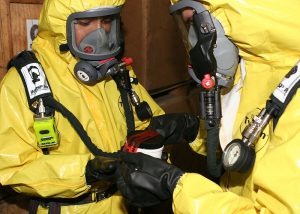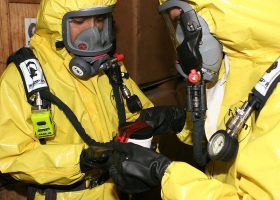
Meanwhile, many Syrian refugees and migrants are living in America. How we deal with this situation will be a measure of our humanity.
It is unlikely that chemical attacks will be launched against us here in the United States but it is always worth being as prepared as possible.
What is the difference between a biological attack and a chemical attack?
Very often chemical and biological attacks are lumped together as if they were basically the same sort of thing. In fact, though there are similarities there are substantial differences. For although they can both linger in the atmosphere for some time, most chemicals and gases last only for a limited period, though of course they can be deadly for that time. Diseases, however, can be spread from one person to another, which means that they can pervade an entire society, unlike gases or chemical poisons.
Bioterrorism is the intentional use of biological agents, or germs, to cause illness. Biological agents are viruses, bacteria, fungi and toxin from living organisms that have illness-producing effects on people plants, or livestock. The effects of a biological agent disseminated in a public place may not be known immediately because of the delay between exposure and onset of illness. Those most likely to identify the symptoms of such attacks are the primary care physicians. School nurses or teachers may be the first to detect an illness from a biological attack in children. Among the biological agents of greatest concern are: anthrax, smallpox, plague, and botulism. A biological agent may be introduced to the system through the skin, or by ingestion or inhalation.
Chemical terrorism involves the dissemination of chemical agents to kill, deliberately harm or incapacitate people. Chemical agents are poisonous gasses, liquids, or solids that have a toxic effect on people, animals, or plants. They are introduced through inhalation or absorption through the skin or mucous membranes from food, water, or the air. An acute chemical event develops rapidly in a defined geographic area. The effects are immediate and obvious. Types of chemical agents include nerve, blood, blister, pulmonary, and incapacitating agents; heavy metals; volatile toxins; pesticides; explosive nitro compounds; flammable or poisonous industrial gases, solids, or liquids; or corrosive industrial acids and bases.
What would you do?
The current US military chemical protective equipment includes a protective mask, battle dress overgarment (BDO), protective gloves, and overboots. You won’t have these so you need to stay calm and try to minimize effects using what you have to hand. You should do these things in the event of a chemical attack:
- Quickly try to define the impacted area or where the chemical is coming from, if possible.
- Take immediate action to get away.
- If the chemical is inside a building where you are, get out of the building without passing through the contaminated area, if possible.
- If you can’t get out of the building or find clean air without passing through the area where you see signs of a chemical attack, it may be better to move as far away as possible and shelter-in-place.
If you are instructed to remain in your home or office building, you should:
- Close doors and windows and turn off all ventilation, including furnaces, air conditioners, vents, and fans.
- Seek shelter in an internal room and take your disaster supplies kit.
- Seal the room with duct tape and plastic sheeting.
- Listen to your radio for instructions from authorities.
If you are caught in or near a contaminated area, you should:
- Move away immediately in a direction upwind of the source.
- Find shelter as quickly as possible
- If you are outside, quickly decide what is the fastest way to find clean air. Consider if you can get out of the area or if you should go inside the closest building and shelter-in-place.
Chemicals are carried on draughts and wind so you want to be up-wind of whatever the agent is. Sadly you would determine that by watching people fall to the ground. Head away from that flow. And if you’re sheltering inside, you need to have fans switched off. Cover your face with a towel or jacket.
Decontamination is needed within minutes of exposure to minimize health consequences. Do not leave the safety of a shelter to go outdoors to help others until authorities announce it is safe to do so.
A person affected by a chemical agent requires immediate medical attention from a professional. If medical help is not immediately available, decontaminate yourself and assist in decontaminating others.
Decontamination guidelines are as follows:
- Use extreme caution when helping others who have been exposed to chemical agents.
- Remove all clothing and other items in contact with the body. Contaminated clothing normally removed over the head should be cut off to avoid contact with the eyes, nose and mouth. Put contaminated clothing and items into a plastic bag and seal it. Decontaminate hands using soap and water. Remove eyeglasses or contact lenses. Put glasses in a pan of household bleach to decontaminate them and then rinse and dry.
- Flush eyes with water. (take care where you flush the chemicals, you don’t want them to affect someone else.)
- Gently wash face and hair with soap and water before thoroughly rinsing with water.
- Decontaminate other body areas likely to have been contaminated. Blot (do not swab or scrape) with a cloth soaked in soapy water and rinse with clear water.
- Change into uncontaminated clothes. Clothing stored in drawers or closets is likely to be uncontaminated.
- The next advice from government is to proceed to a medical facility for screening and professional treatment. The authorities will be overloaded. There will be opportunities for recontamination. Call ahead if you can to determine wait times, numbers, etc. Watch TV and listen to the radio.
